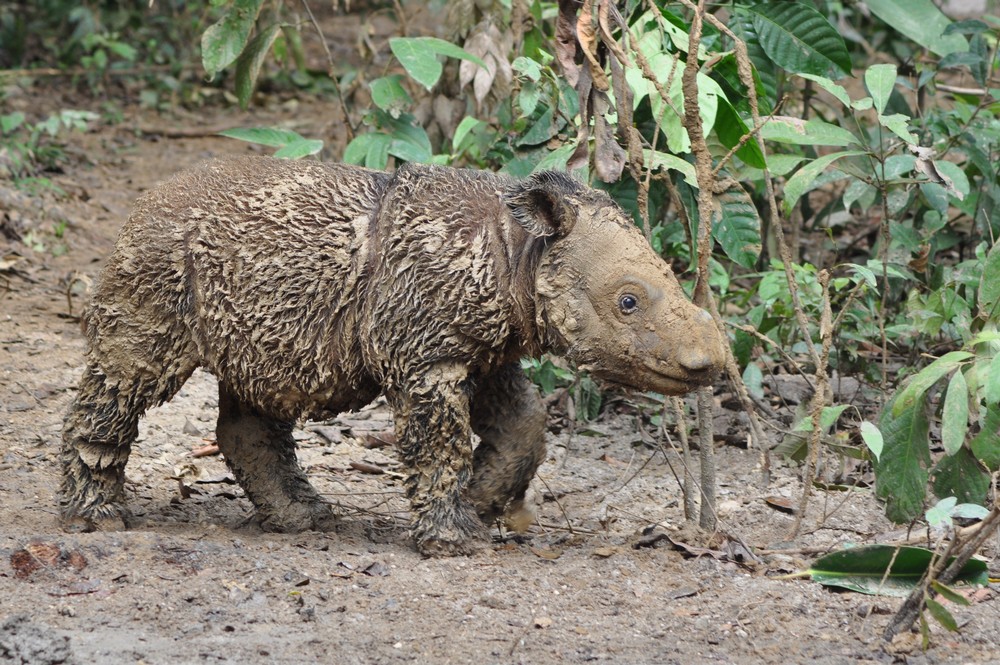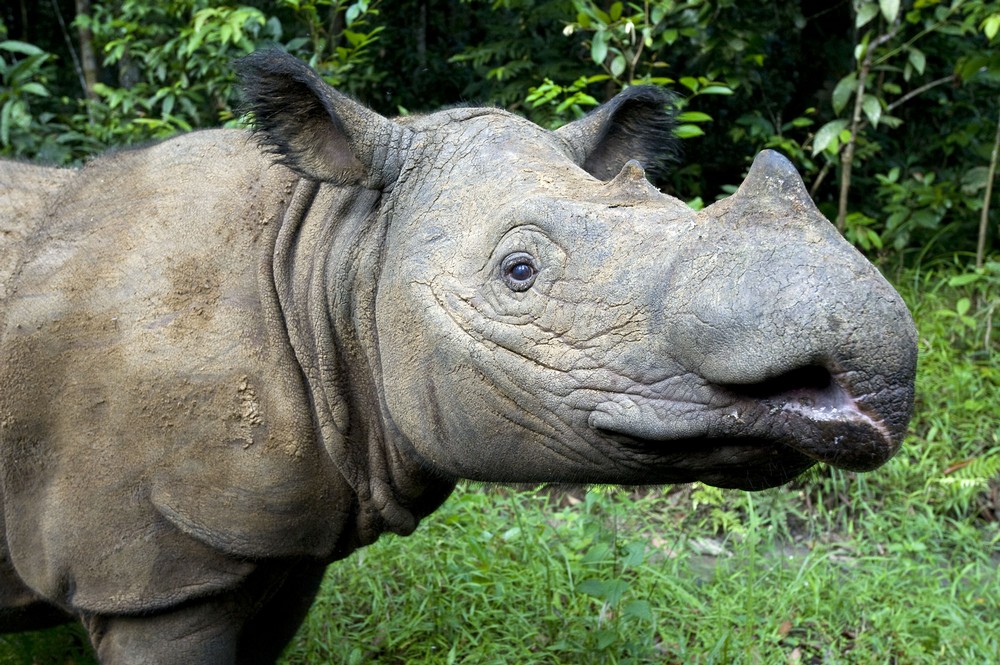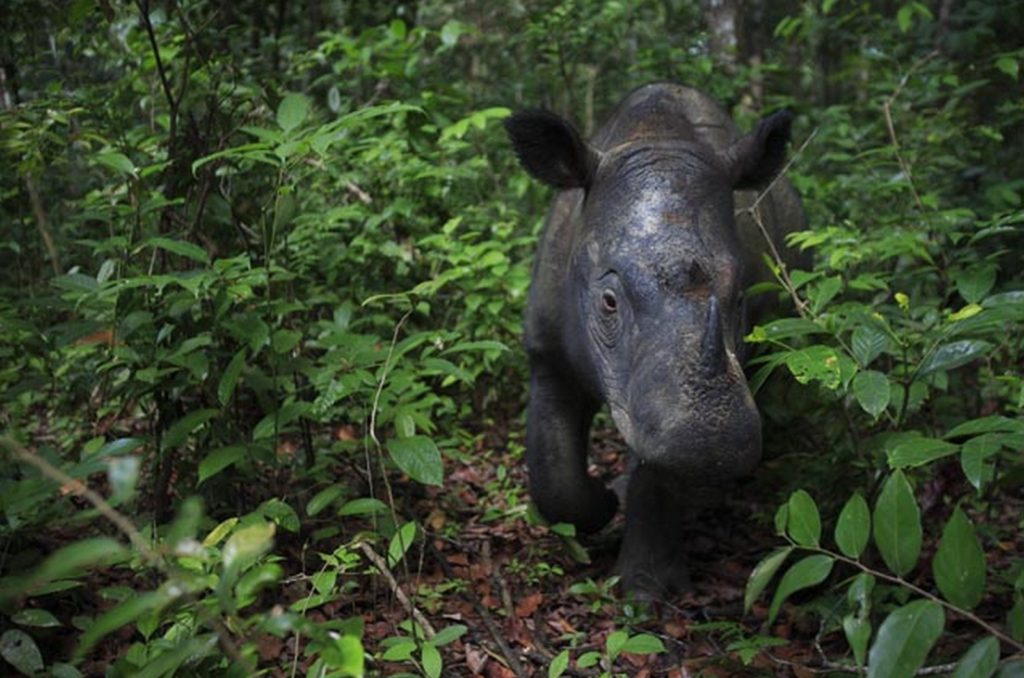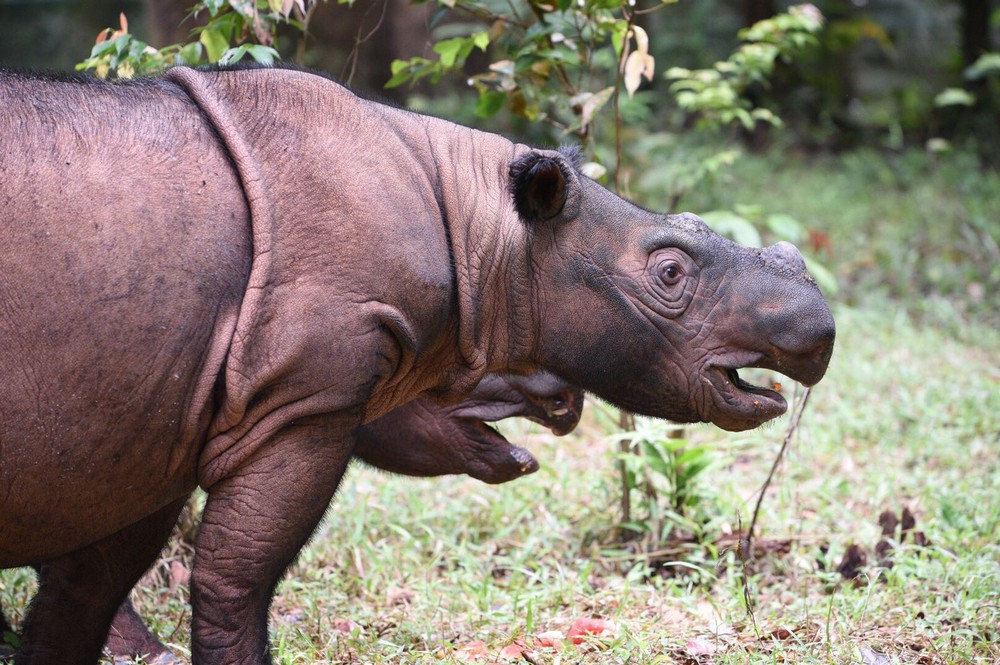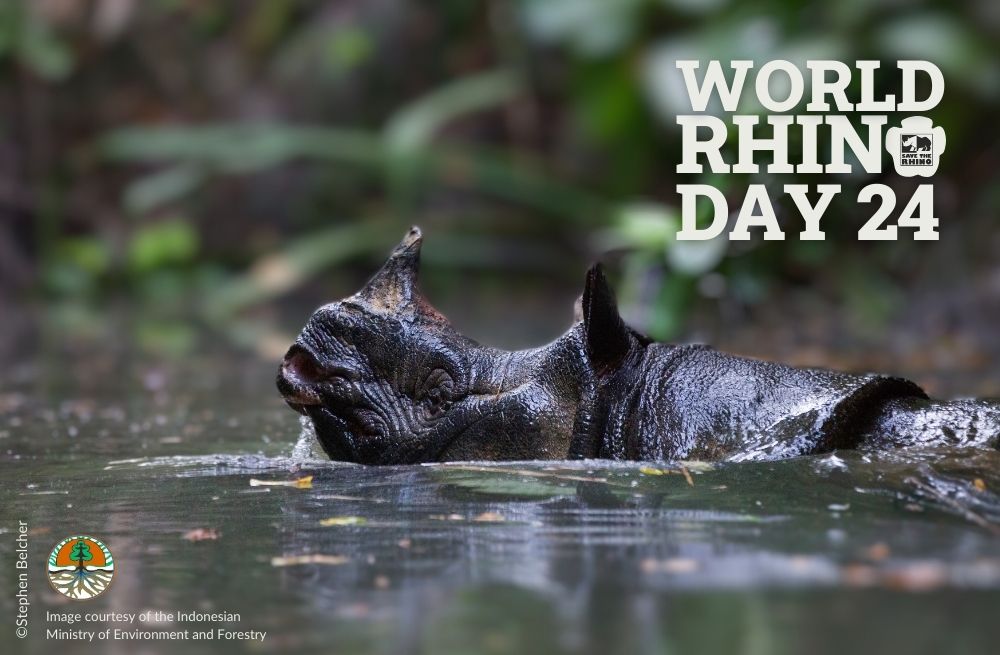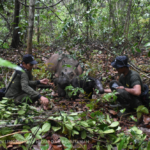Sumatran rhino
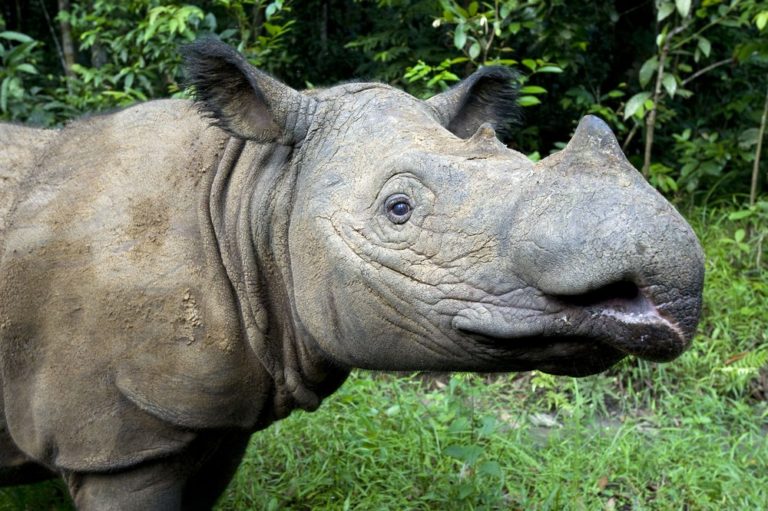
Fun fact:
Sumatran rhinos tend to spend their days sitting in pond or mud wallows to keep cool.
Under threat
In 1986 it was believed there could have been as many as 800 Sumatran rhinos remaining in the wild. Now, more than 35 years later, official estimates suggest there are as few as 34-47 rhinos left in the wild.
The Sumatran rhino has not had an easy ride. Research from the Marshall University in West Virginia recently shed light on just how long the Sumatran rhino population has been having difficulties. It seems that their numbers declined dramatically due to a climate shift as long as 9,000 years ago, and have not managed to bounce back since.
More recently, widespread habitat loss and fragmentation have led to surviving animals struggling to meet and breed in the wild, while the threat of poaching still looms.
Physical characteristics
- Size: Sumatran rhino are by far the smallest species of rhino
- Weight: they weigh between 500-960 kg
- Height: 1-1.5 metres
- Shoulder height: they usually stand at 1.2-1.45 metres and are about 2.5 metres long
- Skin colour: Sumatran rhinos have a reddish-brown skin
- Hair: these are the hairiest species of rhino. This can vary from a short, bristly coat common in the wild, to a shaggy fur for those in captivity because there is less abrasion from vegetation. Their ears have a fringe of longer hairs, and the tail end has a tuft of thicker hairs
- The horn: Sumatran rhinos have two horns that are dark grey to black in colour. In the wild they are usually very smooth and form a slender cone that is curved backwards. The larger front (anterior) horn is typically 15-25 cm long, and the smaller second (posterior) horn is normally much smaller, seldom more than a few cm in length, and often just an irregular knob on the tip of the nose. Rhino horn is made of keratin, which is the same as fingernails and hair fibres. It will re-grow if broken off. It is not used for fighting, but for scraping mud from the sides of wallows, pulling down food plants, as well as aiding the protection of the head and nose when breaking through dense forest vegetation
- Distinctive characteristics: aside from their small size and hairy bodies that distinguish the Sumatran rhinos from other rhino species, they also have unique skin folds. There are two prominent folds in the skin that circle the body behind the front legs and before the hind legs, and lesser folds on the neck and at the base of the legs. The skin is fairly thin, about 10-16 mm, and is soft and pliable. Sumatran rhinos also have a prehensile upper lip, which assists in grasping their food
- Sumatran rhinos can run fast and are very agile. They climb mountains easily and can negotiate very steep slopes and riverbanks. With the protection provided by the horns and rims of hard skin and cartilage on nose and head, they can easily break through the densest vegetation, leaving round tunnels
Location and habitat
- Location: once found across parts of Southeast Asia, including the foothills of Bhutan and northeast India, southern China, Cambodia and Thailand, they are now restricted to just a few sites in Sumatra and Borneo, in Indonesia
- Habitat: the Sumatran rhino lives in dense tropical forest, in both the lowlands and highlands. Sumatran rhinos are well adapted to life in very dense tropical forests. They are primarily attracted to areas with plentiful food resources, such as shrubs, fruits, shoots, leaves and roots
Social behaviour and territory
- Sociability: Sumatran rhinos are usually solitary, except for females with small calves, and during a short period of courtship around the time a female is in oestrous
- Male territory: males have large territories (can range up to 50 km2), which overlap with other males’ territories. There is no indication that these territories are actually defended by territorial fights as happens in other rhino species, but they are marked along the main trails by urine, faeces, scrapes and twisted saplings
- Female territory: females have much smaller ranges (around 10-15 km2), and appear to be quite well spaced but will sometimes overlap with male territories
- Communicating and sounds: the Sumatran rhino is surprisingly vocal and communicates with many different sounds, mostly whistling or whining noises. Dung heaps, or ‘middens’, also serve as a communication point, though the large latrines common in territories of the Greater one-horned rhino do not occur, probably because of the much lower natural density of these animals. However, when a Sumatran rhino meets a heap of dung, it usually deposits a fresh pile nearby. After defecating, Sumatran rhinos scratch their hind feet in the dung and kick it around in the bushes. This probably serves to mark the feet and surrounding tracks with the scent of the faeces. Foot glands, which are present in the Javan rhino, are most likely absent in the Sumatran rhino
- Tracks and trails: Sumatran rhinos tend to use a network of game trails that occur along all the major ridges and rivers. The trails are well defined and are kept open by the regular passage of the larger animals, especially rhinos and elephants. The rhinos use the trails to travel between feeding areas, salt-licks or seasonal movements
Breeding and birth
- Sexual maturity: females reach sexual maturity at around 4 years of age, and males are sexually active by around 7 years of age
- Gestation period: approximately 15-16 months. Sumatran rhinos will have a single calf every 4-5 years
- Birth: The birth weight is 40-50 kg. A calf drinks and grows 1-2 kg daily. They start nibbling from the food hanging from the mother’s mouth at an early age to learn which plants are good to eat but may continue to suckle up to the age of 13-15 months
- Calves: calves may occasionally be predated by tigers or wild dogs, but when they are young they stay very close to the mother at all times, and natural predation is largely insignificant to the mortality rates of the species
Other interesting facts
- Food: the Sumatran rhino is a browser, and its diet consists of a diverse range of tropical forest plant life. They eat the tips of plants growing on the forest floor, browse the leaves from sapling trees that they break to reach the crown and also pull climbers from trees. They feed mostly in small patches of juicy secondary vegetation created by landslides or tree falls and along river banks. They are also fond of fruits that have fallen from the forest trees. Sumatran rhinos eat on average 50-60 kg (almost 10% of their body weight) of plant matter per day
- Historical legend: the Sumatran rhino is considered the most ‘primitive’ rhino species, because of its hairy skin and other prehistoric characteristics. It is the closest living relative to the famous woolly rhinoceros that lived in the frigid lands of Europe and Asia during the Ice Age
- Horn record: the longest horn ever found was 81 cm long, and is now in the British Museum, London
- Teeth: to masticate the large quantities of coarse food, rhinos have two rows of six strong broad and low-crowned molars on each side. The teeth are fitted with strong ridges of enamel, which cut the woody parts in characteristic 1-2 cm long bits. Over the years the teeth wear down by several centimetres to become shallow dish-like structures, and old animals will have problems masticating their food, will lose condition and may eventually die of undernourishment. Sumatran rhinos, like all Asian rhinos, have long dagger-shaped lower incisor teeth. They are very sharp and are used in fighting and can inflict deep wounds. These teeth are lacking in the African rhino species
- Digestion: Sumatran rhinos are hind-gut fermenters, meaning that they use micro-organisms in the last part of the intestine to break down indigestible parts of the food, and have a large cavernous caecum and colon
- Longevity: Sumatran rhinos are estimated to live an average of 30-45 years in the wild, while the longevity record for those in captivity is almost 33 years
- Senses: Sumatran rhinos have a good sense of smell and hear very well, but are rather short-sighted. When encountered in the forest, they usually run away, and attacks on humans are very rare and probably mainly accidental because of the animal’s limited eyesight
- Salt licks: these are an important asset within a Sumatran rhinos’ territory. They usually materialise within small hot springs, seepages of mineral water or so-called ‘mud volcanoes’. Each rhino has a favourite salt-lick that is visited once every one or two months, but much more often when a female is with a calf. These are important for the extraction of vital minerals for the rhino’s health. Wildlife trails lead from all directions to these places, and other animals like elephants, tigers, orangutans and deer also visit these places to get a supplement of scarce minerals. Salt-licks also appear to be important social focal points, where males can pick up scent marks from oestrous females. Unfortunately, the big trails leading to the salt-licks also attract poachers, who place their traps and snares around the licks
- Wallowing: Sumatran rhinos spend a large part of the day wallowing in mud holes. They may use temporary pools and puddles which they deepen with the feet and horn. In mountain areas good places for wallows are scarce, and some are used repeatedly for a very long term, eventually becoming characteristic holes dug in several meters into a slope. The access to mud wallows is essential for thermo-regulation, skin condition and to get rid of ectoparasites (parasites that live on the surface of their host) and biting insects




